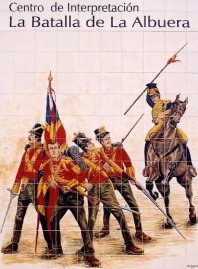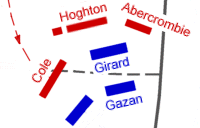
Above: The battlefield of Albuera - looking west and north from the track off the N435. On 5th May 1811, the day on which Wellington defeated Masséna at Fuentes de Oñoro, 200km to the south Badajoz came under siege from a British-Portuguese force commanded by Sir William Beresford. Eight days later, Beresford broke off the siege in order to confront a 24,000-strong relief force under the command of Soult which had left Sevilla in the early hours of the 10th. Beresford, with in excess of 35,000 troops at his disposal - including Spanish armies under Blake and Castaños - marched to face Soult at the town of Albuera. The defensive position chosen by Beresford at Albuera was not a strong one, though arguably it was the best available. The town stands on the west bank of the Albuera river which is fed from the south by two streams, the Chiçaspiernas and the Nogales. Neither the river nor the streams presented much of an obstacle to infantry or cavalry, and artillery too could cross at several places. The gently rolling landscape occupied by Beresford to the west and south of Albuera offered little advantage to the defender, while the woods that then stood to the east of the rivers concealed the movements of the French. Anticipating that Soult would attempt to break through by crossing the river at Albuera, Beresford ordered Alten's German Brigade to occupy the town, and deployed Stewart's 2nd Division on the low ridge behind it. Hamilton's Portuguese Division, supported by Collins' Brigade, was placed on Stewart's left, with Otway's cavalry pushed forward to guard the flank. As dawn broke on 16th May, Blake's Spanish army - which had arrived overnight - began to deploy on Stewart's right. At the same time, Cole's 4th Division and de España's infantry of Castaños' Army came up behind Stewart. Loy's Spanish cavalry guarded the Allied right flank, the 13th Light Dragoons held the riverbank immediately south of Albuera, while the remaining cavalry were to the rear. Beresford's expectation that Soult would strike directly at Albuera seemed to be confirmed when at around 8am the town came under attack from six French infantry battalions (Godinot's Brigade) supported by cavalry and artillery. Behind Godinot, a further nine infantry battalions (Werle's Brigade), with two brigades of dragoons, threatened a frontal attack against Blake. Shortly afterwards, Soult's real intentions were revealed when French cavalry appeared well to the Allied right, scattering Loy's cavalry before them; behind the cavalry came 19 battalions of infantry (Girard and Gazan's Divisions). In response to Soult's advance against his right flank, Beresford ordered Blake to form a new line facing south. The Spanish general, wary of the continued threat from Werle's Brigade, at first chose only to redeploy Zayas' Division, which soon found itself standing alone against the most massive single infantry attack of the Peninsular War. With no further need for deception, Werle's Brigade moved away to form a reserve behind Gazan's Division, while the dragoons rode off to join the cavalry on the French left. Beresford meanwhile ordered Stewart's 2nd Division to support Blake, its place behind Albuera being taken by Hamilton's Portuguese Division.
Above left: Depiction on tile of the attack by Polish lancers against Colborne's Brigade. Above right: The old bridge at Albuera. Firing in 3-deep lines, Zayas' Division held off the French onslaught while the 2nd Division came up. Disregarding Berseford's orders to form a line behind Zayas, Stewart seized the opportunity to throw forward his leading brigade (Colborne's) into an attack against the French left flank. The gamble failed disastrously when a thunderstorm broke over the battlefield, disabling many of the muskets. Under cover of the storm and smoke, Polish lancers tore into Colborne's Brigade, all but destroying three of the four battalions. Scores of the lancers rode on behind Zayas' line where they came under fire from the head of the next brigade in line of Stewart's Division (Hoghton's); even though many of the shots struck down men in Zayas' line, the Spaniards held firm until Hoghton's Brigade was able to replace them in the firing line. For almost an hour, Hoghton's Brigade weathered a firefight of terrible ferocity against Girard and Gazan's Divisions. Beresford - having survived an individual combat with a lancer - was struggling to find support for Hoghton's beleaguered infantry. Seemingly unwilling to commit Cole's 4th Division, Beresford found it slow to bring Hamilton's Portuguese Division into action, and was quite unable to persuade de España's infantry to move into the line of fire. It was Cole himself - encouraged by Hardinge, then Deputy Q.M.G. of the Portuguese army - who ordered his division forward to strike against the French left. Advancing in a line protected on each flank by mobile squares, Cole's Division fought off attacks on its right from French cavalry before coming up against Werle's Brigade, which had been ordered diagonally forward to protect the left flank of the French assault. Following a furious exchange of fire that lasted for some 20 minutes, Werle's Brigade fell back in disorder, hard pressed by Myer's Brigade. With the French right flank now coming under fire from Abercrombie's Brigade, the assault disintegrated. After 4 hours, the fighting came to an end with Soult forming a new line on the low hill between the Chiçaspiernas and the Nogales. Torrential rain again enveloped the battlefield. Before dawn broke on the 18th, the French army began to retire towards Santa Marta. On the 19th, Beresford resumed his siege of Badajoz. French casualties in the battle are generally accepted to have reached around 8,000. The Allies suffered 6,000 casualties, the brigades of Colborne (1,413 casualties from 2,066), Hoghton (1,044 from 1,651) and Myer (1,045 from 2,015) being particularly hard hit. Approaching Albuera along the N432 from the south-east, the low ridge line that Beresford planned to defend is surprisingly clear. Cross the river (the old bridge is just to the north) and turn left onto the N435 signposted to Almendral. Just after the 24.3km post (and 2km from the N432/N435 junction) there is a track to the right which leads into the heart of the battlefield. (There is space for parking on the opposite side of the main road.) In the centre of Albuera, there is a monument to the battle, curiously featuring a bust of General Castaños, and a small museum (very limited opening hours). "A History of the Peninsular War, Volume IV" by Sir Charles Oman, published by Greenhill Books 1996, ISBN 1853672246. "Wellington in the Peninsula 1808-1814" by Jac Weller, published by Greenhill Books 1999, ISBN 1853673811. Maps of Albuera courtesy of The Napoleon Series: The First Position and The Final Attack. Luis Sorando Muzás' article on Trophies of Albuera, courtesy of The Napoleon Series. © Andrew C Jackson 2005
|



